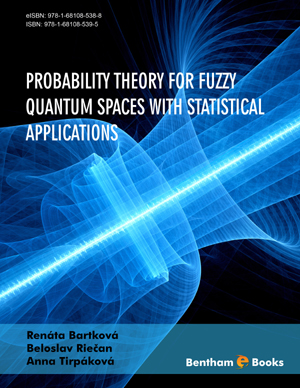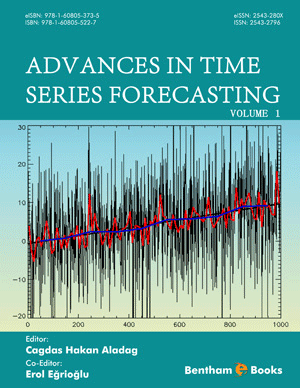Preface
Page: iv-viii (5)
Author: Renáta Bartková, Beloslav Riečan and Anna Tirpáková
DOI: 10.2174/9781681085388117010002
About The Authors
Page: ix-x (2)
Author: Renáta Bartková, Beloslav Riečan and Anna Tirpáková
DOI: 10.2174/9781681085388117010003
Kolmogorov Probability Theory
Page: 1-54 (54)
Author: Renáta Bartková, Beloslav Riečan and Anna Tirpáková
DOI: 10.2174/9781681085388117010004
PDF Price: $15
Abstract
Kolmogorov probability theory based on set theory belongs to the most important results of mathematics of the 20th century. Naturally, its main advantage is the possibility to use results of the modern measure theory. However, this fact sometimes does not allow larger considerations. In this chapter we want to show this paradox can be eliminated. Of course, we present only some basic ideas. Understanding them enables one to study further results and applications.
Probability Theory on Fuzzy Sets
Page: 55-83 (29)
Author: Renáta Bartková, Beloslav Riečan and Anna Tirpáková
DOI: 10.2174/9781681085388117010005
PDF Price: $15
Abstract
Similarly as the Kolmogorov probability theory in the first half of the 20th century, the Zadeh fuzzy set theory played a significant role in the second half of the 20th century. In this chapter we present probability theory on intuitionisic fuzzy sets as well as probability spaces on multivalued logic.
Fuzzy Quantum Space
Page: 84-114 (31)
Author: Renáta Bartková, Beloslav Riečan and Anna Tirpáková
DOI: 10.2174/9781681085388117010006
PDF Price: $15
Abstract
In this chapter we study the existence of a sum of fuzzy observables in a fuzzy quantum space which generalizes the Kolmogorov probability space using the ideas of fuzzy set theory. We also study some properties of the sum of fuzzy observables. To study the above mentioned, we also include the basic notions from the probability theory on fuzzy quantum space in this chapter, i.e. the notion of fuzzy quantum space, a fuzzy observable, an indicator of a fuzzy set, a null fuzzy observable, a Boolean algebra on fuzzy quantum space, fuzzy state etc.
Limit Theorems
Page: 115-152 (38)
Author: Renáta Bartková, Beloslav Riečan and Anna Tirpáková
DOI: 10.2174/9781681085388117010007
PDF Price: $15
Abstract
In this chapter we introduce selected limit theorems on fuzzy quantum space, namely Egorov’s theorem, Central limit theorem, Weak and strong law of large numbers, and extreme value theorems for fuzzy quantum space. We also study here the Ergodic theory for fuzzy quantum space and Ergodic theorems and Poincaré recurrence theorems for fuzzy quantum dynamical systems, the Hahn-Jordan decomposition and Lebesgue decomposition for fuzzy quantum space.
Statistical Applications
Page: 153-167 (15)
Author: Renáta Bartková, Beloslav Riečan and Anna Tirpáková
DOI: 10.2174/9781681085388117010008
PDF Price: $15
Abstract
In this chapter we compare two methods applied to reduce the dimensionality of data sets. The first method is Principal component analysis, and second method is Factor analysis. We present these methods on data from Atanassov’s intuitionistic fuzzy sets [6]. Earlier we construct an example of applying these methods. The calculations are performed in program R.
Bibliography
Page: 168-173 (6)
Author: Renáta Bartková, Beloslav Riečan and Anna Tirpáková
DOI: 10.2174/9781681085388117010009
Subject Index
Page: 174-178 (5)
Author: Renáta Bartková, Beloslav Riečan and Anna Tirpáková
DOI: 10.2174/9781681085388117010010
Introduction
The reference considers probability theory in two main domains: fuzzy set theory, and quantum models. Readers will learn about the Kolmogorov probability theory and its implications in these two areas. Other topics covered include intuitionistic fuzzy sets (IF-set) limit theorems, individual ergodic theorem and relevant statistical applications (examples from correlation theory and factor analysis in Atanassov intuitionistic fuzzy sets systems, the individual ergodic theorem and the Poincaré recurrence theorem). This book is a useful resource for mathematics students and researchers seeking information about fuzzy sets in quantum spaces.












